Sandy put a presidential election season on hold, brought the global center of finance to its knees, and literally changed the shape of the East Coast. It upended whole communities in New York and New Jersey and merged with a nor'easter to drop damaging rain and snow on six other states.
The storm caused widespread interruptions to water and electricity, leaving millions without power for days. The New York Stock Exchange closed for two consecutive business days – the first time that happened since a major winter storm in 1988. In total, Sandy cost the area $65.7 billion and caused 159 fatalities.
Sandy was an inspiration for New York City's $20 billion plan to protect against the effects of climate change. Mayor Michael Bloomberg announced the plan earlier in June and many other cities and regions across the world are considering or implementing simliar plans in anticipation of future storms.
"As bad as Sandy was, future storms could be even worse," Mr. Bloomberg said in his speech unveiling the plan. "In fact, because of rising temperatures and sea levels, even a storm that's not as large as Sandy could – down the road – be even more destructive."







